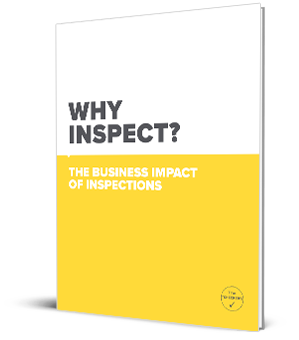Increased safety and compliance aren’t the only benefits of improving inspection processes. The maintenance department also gets a major boost.
In relation to maintenance, better inspection processes result in:
1. Equipment problems being detected and receiving maintenance attention before they escalate into costlier issues. When equipment isn’t functioning properly, it is usually at high risk of increased damage if operated—either from an accident or from further mechanical problems resulting from the initial problem.
All equipment wears, but that doesn’t mean it has to break. When you can pinpoint how often a particular type of equipment needs a certain repair, you can schedule that repair before failure occurs—thereby reducing repair costs and minimizing downtime.
3. Recurring equipment problems being identified so that their causes can be corrected. Inspections give you the data to quantify trends with equipment problems, as well as to isolate causes. Often, when equipment has a recurring problem, it’s due to systematic misuse, and inspections can bring this operational issue to light.
4. Personnel taking better care of equipment because regular inspections hold them accountable. Pre-use inspections uncover personnel who are abusing their equipment, which is the first step in taking action to stop that behavior. However, more often than not, simply doing pre-use inspections causes personnel to have a higher regard for the condition of their equipment—making the threat of punitive action largely unnecessary.
5. Procurement of better equipment due to the information being gathered about equipment durability and performance. Inspection data helps you evaluate equipment you’re using so you’ll know whether you want to keep using it.
Realizing the Benefits
Two elements must be present to gain these maintenance benefits: properly conducted inspections and good communication of the results to maintenance.
If inspections aren’t thorough, with all the critical items for each piece of equipment checked, then the information the maintenance department receives won’t be accurate enough to significantly improve decision-making and planning. Indeed, the information could be misleading.
And, of course, if maintenance personnel don’t receive the information in a timely manner (or at all), then they can’t act on it in a way that increases productivity and saves the company money.
The solution is to establish a process that guides personnel in how to do inspections correctly, while also facilitating communication of the results. The Checker is such a system. The Checker inspection checklists are easy to follow and, critically, they are specific to each type of equipment being used, meaning they provide the detailed information that maintenance needs. The results, documented in the checklist forms, can easily be communicated with maintenance—if a process has been established to ensure timely, consistent sharing of this information.
An ideal solution is The Checker Mobile, in which The Checker inspections are done on mobile devices and the results are automatically sent to the appropriate people, while also being instantly archived for analysis.
Takeaway
If pre-use equipment inspections are regularly done the right way, and the results are quickly shared with maintenance, companies can lower maintenance costs, extend the life of equipment, and increase operational productivity.











